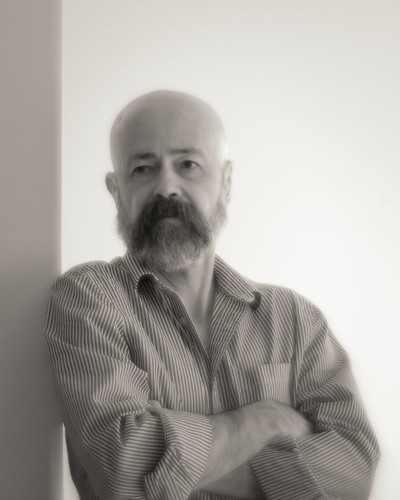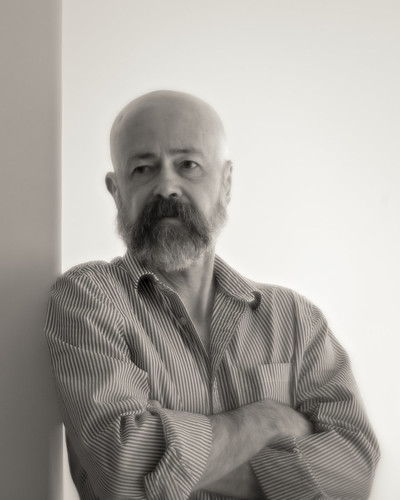After confirming that Pentax's 85mm f/2.2 Soft instruction manual provided good guidance on how to use this lens, I thought I'd like to see how the lens plus the 1.4x teleconverter worked at portraiture distances.
The reason for this is that as the Pentax is stopped down to f/4 and beyond, a "resolution hole" starts to open and the edges of the frame a strangely rendered. At portraiture distances the effect is fairly well hidden (which I will illustrate below), but if I stare at a photo long enough I find I might not be entirely happy with the result.
Hence this blog entry.
Before I get to the comparisons I'd like to say that this has been a very interesting exercise. I have learned a tremendous amount by listening, reading, looking, and considering the many details. This is such a complex area of photographic practice that I can see why some people might feel these lenses are simply too difficult to use.
Heretical Thought: The parameters for sorting out how best to use this Pentax 85mm f/2.2 Soft likely (or most certainly) apply to other meniscus design soft focus lenses, regardless of focal length or film emulsion dimensions or digital sensor size.
In typing the previous paragraph I realize I'm going against the grain of conventional wisdom. I would really enjoy having a conversation about this to see if I can improve my understanding, particularly with people who might have a deeper understanding of optical physics and lens design than I.
To once again express my current understanding of the areas this Pentax Soft operates in and the effects lens controls have -
- Control ~ subject matter distances
- Close-up ~
- NOTE: put the subject dead center in the frame and crop accordingly in processing so as to avoid any "resolution hole" transition area effects as the aperture is stopped down
- Portraiture ~
- NOTE: put head of the subject dead center in the frame and crop accordingly in processing so as to avoid any "resolution hole" transition area effects as the aperture is stopped down
- Control ~ aperture
- Maximum under-corrected spherical aberration (veiling softness) is seen at f/2.2
- Decreasing under-corrected spherical aberration in the center of the frame as the aperture is stopped down
- Opening of a "resolution hole" in the center of the frame from f/4 thru f/5.6 - with attendant edge softness and harsh sharp/soft transition zone effects
- Control ~ telextender/teleconverter
- Enlarge the center of the field of view...
- ... thus pushing the harsh sharp/soft transition zone to the edges of the frame
- Potentially useful for landscape work
- Prediction that a 2x telextender might completely pierce the "resolution hole", much like a designed for whole plate 11.5inch (292mm) Wollensak Verito f/4 would completely avoid the "resolution hole" effect when shooting the lens on 4x5inch film
- Note: Nothing is being said about city scapes, street photography, large man-made objects, or technical applications were accuracy and clarity tend to be preferred. I believe that people and nature may be the areas where soft focus lenses succeed most easily. YMMWV.
Another Heretical Thought: If I pay attention to completely controlling the lens, if I pay attention to the colors of the scene to emulate early light sensitive emulsions, and if I pay attention to expressing the dynamic range to emulate early film and print characteristics, I'm now of the opinion that the earlier Pictorialist effects are achievable using current day digital equipment.
That's a lot to bite off, I know. Please challenge me if you don't think I'm right. Again, I would invite the conversation. I love talking about this stuff, particularly over a proper pint of Belgium beer.
Continuing to abusing myself as a subject and so as to not scare the women and horses, viewer discretion is advised.
It's darned difficult to find or hire decent help these days. The modeling industry has changed significantly since moving to Europe eleven years ago. It wouldn't surprise me at all to learn that cell-phones, CGI, and now AI have taken their toll on the old practice of model photography.
Setup ~
- Camera -
- Sony A7, 100ISO, 2sec timer, "A" mode, +1EV
- Lens -
- Pentax 85mm f/2.2 Soft at f/4, f/4.8 (see comments under each photo)
- Bogen tripod
- RawTherapee -
- Global contrast increased by image to taste
- Local Contrast increased by image to taste
- In one image B&W Channel Mixer red filter
Image Processing Comparison ~
As always, click on the image and enlarge to 100percent to see whatever there is to be seen.
Pentax 85mm f/2.2 Soft at f/4
B&W Channel Mixed Blue-Green Filter
Local Contrast enhanced
Pentax 85mm f/2.2 Soft at f/4.8
+ Sigma 1.4x APO telextender/teleconverter
B&W Channel Mixed Red Filter
Local Contrast enhanced
Pentax 85mm f/2.2 Soft at f/4.8
+ Sigma 1.4x APO telextender/teleconverter
B&W Channel Mixed Blue-Green Filter
Local Contrast enhanced



2 comments:
Thank you for pursuing this fascinating subject with such enthusiasm and energy! I agree completely with your conclusions thus far about the resolution hole and the use of a tele-extender to widen the usable center of the lens you're experimenting with.
As a Verito user (but far from being an optics engineer), I can add these two tidbits:
1) Wollensak encouraged photographers to experiment by removing the front element of the Verito, which had the effect of nearly doubling the focal length of the lens. This, of course, expanded the circle of focus tremendously, thus opening the resolution hole. The rear element alone behaves more like a monocle, but severely cropped much as you are doing.
2) Taking this one step further, I've had some success adding a tele-extender to a 9" Verito whose front element has been removed. The Verito continues to have a very pleasant background blur, but anything in the foreground gets blobby rather than blurry.
All of these experiments, yours and mine both, result in something like a "telephoto" lens which, of course, foreshortens and compresses the field of view. This can be useful in some situations but not in others. For situations where a wider angle is needed, a wide-angle extender on a Verito will (as one might predict) pull the resolution hole more toward the center.
In the end, what we are calling the "resolution hole" may in fact be a spherical (parabolical?) field of focus. This is useless information with regard to portraits but might in fact be an advantage in landscape situations where both foreground and background happen to fall into the sweet spot. Early lens catalogs, particularly for Petzval lenses, talk about using such lenses for group photos in which the people are arranged in a semicircle that matches the shape of the focus field.
Carry on, and thanks again!
Dan
DAW - Yes! Thank you for everything you just said.
These things really do add to my understanding of how to best use these interesting/fascinating/somethings-frustrating lenses.
Post a Comment